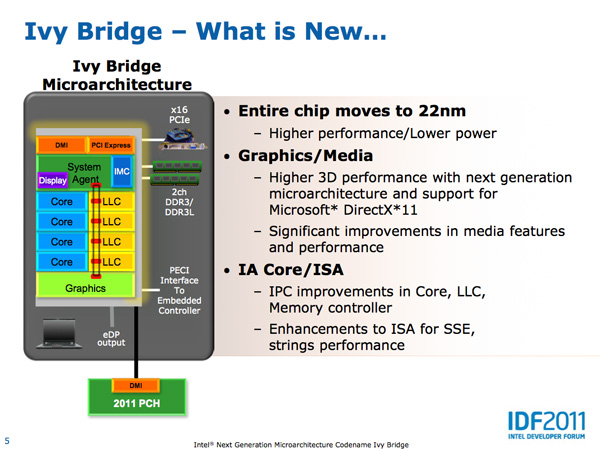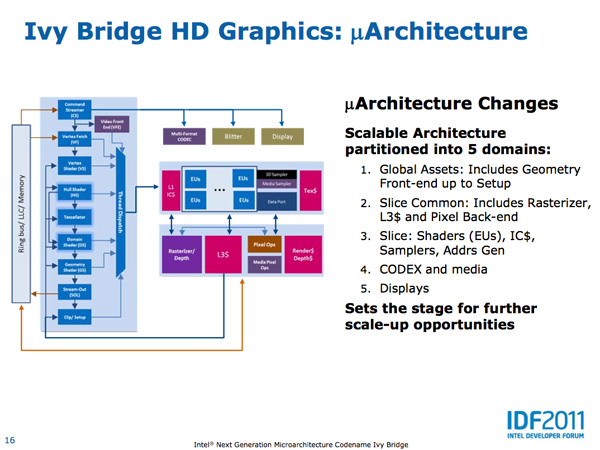The Ivy Bridge Preview: Core i7 3770K Tested
by Anand Lal Shimpi on March 6, 2012 8:16 PM EST- Posted in
- CPUs
- Intel
- Core i7
- Ivy Bridge
Ivy Bridge Architecture Recap
At IDF Intel disclosed much of Ivy's CPU architecture, but below is a quick summary:
- 4-wide front end with µOp cache from Sandy Bridge
- OoO execution engine from Sandy Bridge
- Data structures previously statically shared between threads can now be dynamically shared (e.g. DSB queue), improves single threaded performance
- FP/integer divider delivers 2x throughput compared to Sandy Bridge
- MOV instructions no longer occupy an execution port, potential for improved ILP when MOVs are present
- Power gated DDR3 interface
- DDR3L support
- Max supported DDR3 frequency is now 2800MHz (up from 2133MHz), memory speed can be moved in 200MHz increments
- Lower system agent voltage options, lower voltages at intermediate turbo frequencies, power aware interrupt routing
- Power efficiency improvements related to 22nm
- Configurable TDP
I've highlighted the three big items from a CPU performance standpoint. Much of the gains you'll see will come from those areas coupled with more aggressive turbo frequencies.


On the GPU, the improvements are more significant. Some of the major changes are below:
- DirectX 11 Support
- More execution units (16 vs 12) for GT2 graphics (Intel HD 4000)
- 2x MADs per clock
- EUs can now co-issue more operations
- GPU specific on-die L3 cache
- Faster QuickSync performance
- Lower power consumption due to 22nm






















195 Comments
View All Comments
retrospooty - Wednesday, March 7, 2012 - link
"Nice to see AMD winning where it actually matters for most consumer applications."I dont see how you can look at these (or any) benchmark and call it a win for AMD. Intel is smoking them. A few useless integrated graphics benchmarks and you call it a win? Hey, I hear RIM is looking for a new PR rep, they could really use a guy like you. ;)
juampavalverde - Tuesday, March 6, 2012 - link
IGP performance is nice, but no comments about the subjective quality, i have seen side to side HD Graphics 2000 vs Radeon IGP and the graphics quality was night and day, with the radeon being the day...I dont know whats needed to do properly integrated graphics, but seems intel still lacks...
nuha_te10 - Tuesday, March 6, 2012 - link
Yes,people standard are different. For gamer intel IGP might suck, but it's more than enough for me.If I buy Llano, the graphic core might be just a wasted silicon because I don't really do gaming.Buy 1 if you only need 1lowenz - Tuesday, March 6, 2012 - link
OK, DirectCompute is supported by the GPU: we see the fluid benchmark in review.But GPU is OpenCL 1.1/1.2 compliant?
ltcommanderdata - Tuesday, March 6, 2012 - link
You mentioned in your intro about the Intel-Apple exclusivity agreement being up and Apple constantly pushing Intel for better GPU performance. Do you think Ivy Bridge has made sufficient gains in GPU performance to keep Apple on board? Have you had a chance to test Ivy Bridge's IGP OpenCL performance since that seems like a particular area of interest for Apple?tipoo - Tuesday, March 6, 2012 - link
I think its sure that they will. They chose a weaker CPU in favour of a stronger IGP (9400 and Core 2 Duo) before, but now we're at a point where the HD4000 would be more than adequate for Mountain Lion and probably onwards, plus Intel is way ahead with 22nm and the resulting power draw as well as CPU performance, and I think Apple uses Quicksync for Airplay which is Intel-only.Exodite - Wednesday, March 7, 2012 - link
It really depends on your workload.Personally I need CPU grunt far more than GPU grunt, which I suppose means I wouldn't even strictly need the 4K class GPU.
But it's 'free' so I'll take it. :)
tipoo - Tuesday, March 6, 2012 - link
The top end models which would probably be paired with a discreet card get decent integrated graphics, while the low end ones which will probably be standalone get cut down IGPs. Odd. If anything I think on the top end people would want models with less space used on integrated graphics with that headroom used for higher clocks or lower prices, even the cut down IGPs can do Quicksync.Also a suggestion for the full review, we know pretty much to expect from the HD4000 performance wise, but what about image quality? AMD and Nvidia improved things generation after generation, and I doubt Intel got it right with their first or second serious foray into lower-midrange graphics.
lowenz - Tuesday, March 6, 2012 - link
Apple?If IGP supports OpenCL as well as DirectCompute there's no more reason for a AMD APU for pro users not gamers.
tipoo - Tuesday, March 6, 2012 - link
Seriously, this is too much, its fine that you have an opinion and I might not have a problem with it if you posted it once, but you post the same damn thing on every article whether its related or not and usually multiple times, someone just please do us all a favour and ban this guy and delete his comments?